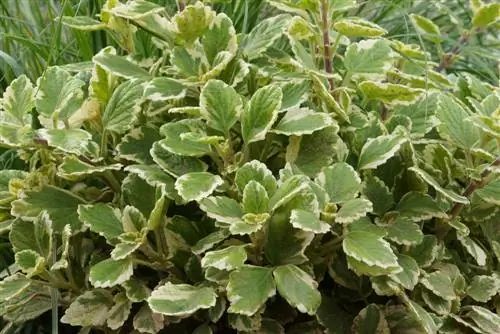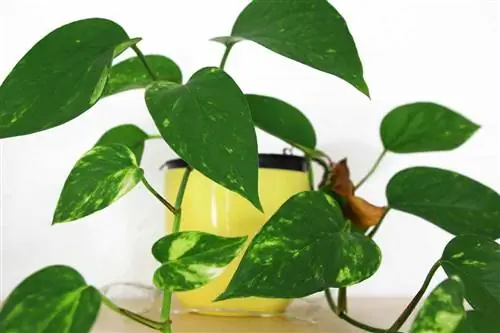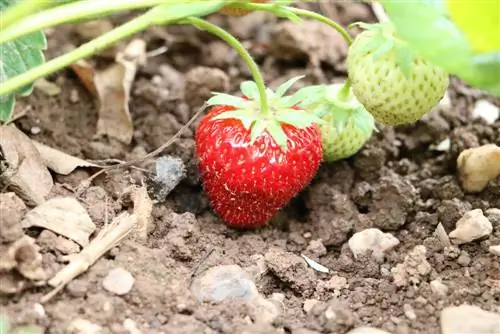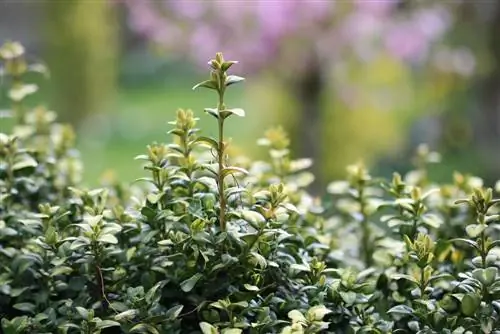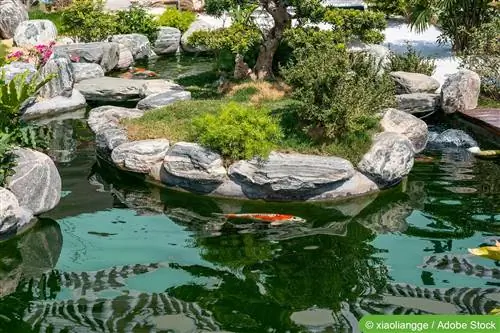- Author admin [email protected].
- Public 2023-12-17 03:39.
- Last modified 2025-06-01 06:48.
The frankincense plant (Plectranthus coleoides) originally comes from India and is a popular balcony plant in this country. There are now numerous hybrids of the plant, which differ primarily in their leaf colors and patterns. The plant, which smells slightly of incense, is offered as a green ornamental plant because it produces labial flowers, but these are very inconspicuous. Although its spicy scent is reminiscent of real frankincense, it is not related to it, but it has gained a reputation as a plant against moths and mosquitoes.
Location
The frankincense plant prefers sunny locations, without blazing midday sun, and should be planted in partial shade at most, where ideally it gets at least a few hours of sun. If the plant does not receive enough light, this does not directly inhibit growth, but the leaf colors fade and the spaces between the individual leaves become larger, which means that it is no longer as attractive and appears to have holes. Depending on the variety, the plant is upright to drooping and can reach a height of 20 to 30 cm - hanging shoots often even reach a length of several meters if well cared for. When choosing a location or planter, size should also be taken into account so that it can spread well and not overgrow other plants.
Substrate
The frankincense plant also has low demands on the soil. Commercially available potting soil is completely sufficient. This can be supplemented with compost, for example, which means that fertilization is required less frequently. The compost should preferably be a substrate based on leaf mold, although normal garden compost can also be used. The substrate itself should be loose and no waterlogging should occur, otherwise the roots will begin to rot. To prevent waterlogging, the bottom of the planter should be covered with some clay granules. Mineral substrate can also be mixed with the soil, which on the one hand allows water to be stored and on the other hand loosens the potting soil. Basically, plants that have been overwintered should be placed in a new substrate every year so that the soil always remains permeable.
Tip:
Pottery shards from old or broken planters can also be used as drainage for the bottom of the pot.
Pouring
- The frankincense plant should always be kept moist, but without causing waterlogging.
- When watering, make sure that the pot ball has been watered thoroughly.
- Particularly hanging varieties of the frankincense plant are very sensitive to drought.
- Adding mineral substrate helps the plants. to be able to store the water.
- During the growth phase, the plant must be regularly supplied with water on particularly hot days.
- Not only should the roots be supplied with water, but hanging shoots should also be sprayed.
- It was preferable to use soft, stale water at room temperature.
- If rainwater is available, this can be used, but should be filtered before use.
- So that no residue gets onto the leaves due to algae formation.
Fertilize
Incense plants, like other balcony or potted plants, are fertilized once or twice a month, provided there is no long-term fertilizer in the substrate. In principle, the nutrient requirement is very low, but care should be taken when planting the frankincense plant with other ornamental plants in the same pot that everyone is supplied with sufficient nutrients. A commercially available fertilizer for balcony or green plants should be used as fertilizer. Long-term fertilizer can also be given in the form of fertilizer sticks, meaning that liquid fertilizer only needs to be given every other month at most. Freshly repotted or newly purchased plants should only be fertilized after six to eight weeks at the earliest. This encourages good root formation, as they spread quickly in search of nutrients and the plant can later absorb the fertilizer better and therefore grow better.
pruning
Although it is not necessary to cut the incense plant, it can happen that the individual shoots become annoying, for example in hanging baskets, and you have to shorten them. The plant can easily cope with shortening individual shoots or pruning and can be carried out throughout the entire growing season. For older plants, you should avoid cutting into shoots that are already woody. Only if absolutely necessary should you cut into older parts of the plant, as the plant takes longer to recover. The plant should always be cut with a sharp knife so that the stems are not bruised. Older, woody parts of the frankincense plant should be cut with sharp secateurs.
Tip:
Species with particularly pretty foliage are also often used as decoration or as part of bouquets, which also does not harm the plant.
Wintering
Since the plant comes from a warm, frost-free country, it usually does not survive the winter outdoors. - The frankincense plant needs a minimum temperature of 18 °C in order to grow, which is why it can easily be overwintered as a houseplant in frost-free rooms.
- The frankincense plant is brought into the house in October at the latest and should only be supplied with moderate water until March - but only at the root ball.
- During wintering, temperatures should be between around 14 °C.
- Do not fertilize during the rest period in winter.
- Only from March onwards will watering be increased again and the first fertilizer applications begin.
Before wintering, the plant can be cut back again and the cuttings obtained from it can be used to grow new plants.
Pests and diseases
With optimal care, the frankincense plant is not susceptible to pests or diseases. However, occasionally it can happen that pests spread on the plant despite the intense smell.
- Aphids: The frankincense plant is rarely attacked by aphids and then only by a few animals. The plant should be checked occasionally, as the lice can also come from neighboring plants and can be controlled with suitable pesticides.
- Spider mites: Infestation by spider mites is much more common, and their webs usually only become visible when sprayed with water. Here too, a suitable pesticide should be used to combat the pests.
- Whitefly: The damage caused by the whitefly is particularly noticeable because its larvae suck the plant sap from the leaves and these then fall off. If the plant sheds more leaves, the undersides of the leaves should be checked and, if necessary, the perennial should be treated with pesticides.
Frequently asked questions
Can the frankincense plant also be cultivated as a houseplant?
Basically yes, but it then exudes an intense scent in the house, which not everyone enjoys. You should also give the incense plant a rest period in the room.
Can the frankincense plant be used like real frankincense?
No. The frankincense plant is not to be confused with the frankincense tree and is a purely ornamental plant. In addition, the plant should be at a height where it cannot be nibbled by pets.
What you should know about the frankincense plant soon
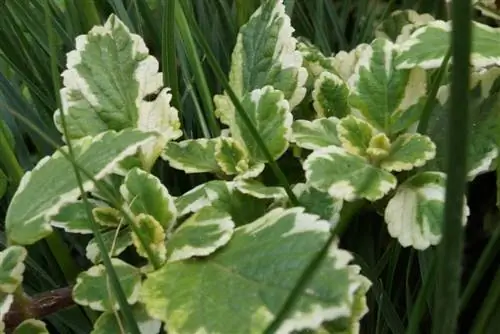
The frankincense plant (Plectranthus coleoides) is not related to boswellia. It is so named because it emits a scent similar to incense. This spreads without touching the plant at all. This must be taken into account if the frankincense plant is to be cultivated as a houseplant. It is also known as the 'harp bush'. Due to the intense incense scent, this plant is also known as the 'moth king', as it is said to keep moths and mosquitoes away. In addition, the frankincense plant is a representative of cat herbs, which is said to have a repelling effect on dogs and cats.
Propagation by cuttings
Especially the older frankincense plants sometimes do not offer a presentable appearance. We recommend:
- the propagation or rejuvenation of the frankincense plant through cuttings
- A branch of the plant is divided in such a way that a few cuttings are created which have one or two side shoots
- the lowest side shoots are removed and
- the cuttings inserted directly into the potting soil
- To ensure compact growth, several cuttings should be placed in one container
- The optimal location for growing frankincense plants is bright, at just over 20 °C, but without direct sunlight
- The plant substrate should have uniform moisture.
The frankincense plant is one of the plants that takes root extremely quickly. Within 8 weeks the cuttings usually already have strong leaves.
Substrate and sufficient nutrients
The frankincense plant is predestined to be planted in flower pots and boxes. The runners of this plant can easily grow to a length of two meters. The frankincense plant should first be placed in outdoor areas such as balconies or terraces:
- when there is no longer any frost to be awakened
- basically the frankincense plant also needs a bright and sunny location
- A commercially available potting soil is completely sufficient as a substrate for planting
- This should be evenly moisturized without getting wet
- During hot summer weeks, daily watering may be necessary as the planters warm up
- So that the frankincense plant is optimally supplied with nutrients, conventional liquid fertilizers and fertilizer sticks (1/2 each) are suitable
- Liquid fertilizer is only administered once a month
- freshly repotted or newly acquired frankincense plants do not need any fertilizer in the first 6 to 8 weeks
Wintering
Since the frankincense plant is by no means winter hardy, it has to leave the outdoor area to overwinter. The frankincense plant cannot tolerate increased rain showers or long-lasting moisture such as fog or waterlogging, which can occur in flower boxes and pots, for example. The ideal place to overwinter the plant is, for example, a moderately temperate, semi-dark cellar. In a warm boiler room with light, however, 'horny shoots' are at risk. These unsightly thin shoots can be cut back in spring, but doing so can damage the incense plant. The rule of thumb for a well-kept ambience is:
- a temperature below 20 °C but above 5 °C
- indirect lighting up to semi-darkness
- the brighter and warmer the incense plant is, the more often the plant needs to be watered
- If there are ideal wintering conditions, constant watering only needs to be done rarely
- so no watering 'in reserve', as the risk of rotting roots is much greater in the winter weeks than in the rest of the gardening year
- Water sparingly from above, as water is used much more slowly during this time (plant metabolism is on the back burner).
If the frankincense plant has lost almost all of its leaves during the winter, it still does not need to be disposed of. If the weather permits, it can simply return to its usual place outdoors and will show fresh leaves again in a short time.
Attention: Don't mix it up
This frankincense plant should not be confused with real frankincense. Plectranthus coleoides is a hanging plant that is primarily known from planting in balcony boxes. When you rub the leaves, they give off a scent similar to incense.

